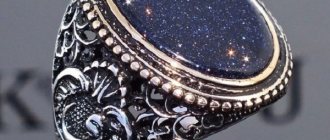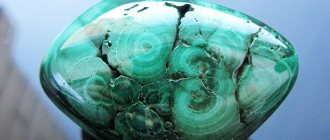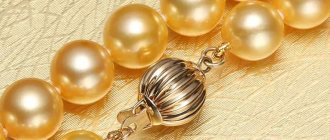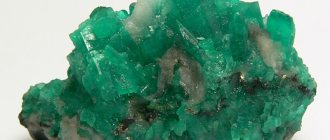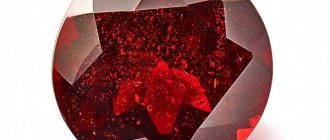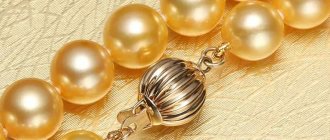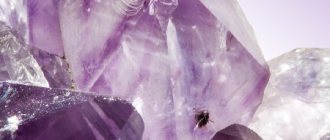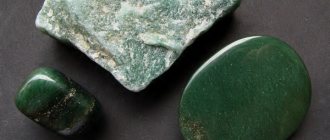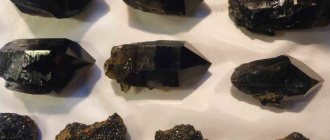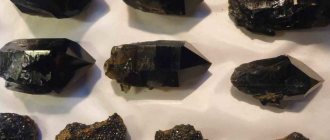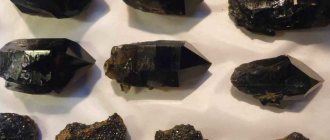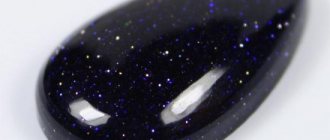| Category | Quartz |
| Title in English | Aventurine |
| Formula | SiO2 |
| Group | Fine-grained quartzite |
| Color | Green, Red-brown |
| Stroke color | White |
| Shine | Fatty |
| Transparency | Opaque |
| singonia | Trigonal |
| Hardness | 7 |
| Cleavage | Missing |
| Density, g/cm³ | 2.6 g/cm³ |
| Kink | Conchoidal |
| origin of name | The name of the stone comes from the Latin word “per avventura”, which translates as “accident”. Somewhere in the 18th century, on the territory of the Italian island of Murano, there lived a worker who, by chance, dropped several copper sections into a bowl of molten metal. An interesting red glow and accompanying seething appeared. This is how the first sample of goldstone or glass made from aventurine appeared. |
| Morphology | The rock is characterized by the presence of minerals of plugged and isometric forms. |
Place of Birth
Australia, Norway, Chile, Austria, Brazil, India, Spain, and the USA are countries where deposits of various types of aventurine are located.
For example, aventurines from America are known as “golden stones.” The green variety of this mineral is common in India. The latter was also very popular among the ancient Chinese as the sacred “Emperor Stone”, since it was from it that the state seal was made.
— Advertising —
Since 1810, aventurine began to be mined in the south of the Urals.
Medicinal properties of aventurine
- Experts in the field of stone healing are convinced that aventurine is a healing stone . It has a positive effect on the central nervous system and brain. The only exception is the black variety. Regular use of the mineral helps normalize sleep and balance the emotional background.
- The stone helps in the prevention and treatment of skin diseases, including eczema and psoriasis. To see noticeable positive results, apply the crystal to the affected area several times a day and keep it with you at all times. The use of light-colored stones helps eliminate headaches or toothaches.
- It is believed that aventurine helps cope with diseases of the respiratory system. If you regularly wear a pendant or pendant made of this mineral, you can cure thyroid diseases. Yellow aventurine helps remove kidney stones.
The stone is extremely useful.
Wearing a ring made of this stone helps:
- removing excess fluid from the body
- normalization of body weight
- decreased appetite
Story
The Italian word "aventura", which is the parent word for the name of the stone, translates as "happiness" and "adventure".
According to legend, this name was given to the stone in the 16th century in honor of its resemblance to the artificial material that Italian craftsmen obtained when copper filings got into the glass melt. The sparkling material looked very similar to natural stone. The mineral has been known since ancient civilizations. In ancient India, the stone served as a talisman for fakir and snake charmer. In the Middle Ages, Indian merchants brought aventurines to Europe, where their beauty was appreciated.
Aventurines have been known in Russia since the 18th century, and became especially popular after the discovery of deposits in the Urals. The mineral was used to make jewelry, vases, candlesticks, and cutlery. A vase with a height of 150 cm and a diameter of about 250 cm has been preserved in the Hermitage.
Aventurine deposits
There are several deposits of aventurine in different parts of the Earth: Russia, India, China, Australia, Brazil, America, Spain and about. Madagascar. Its color depends on the place where the stone was found.
Aventurine mined in Russia (Ural) is reddish-brown in color. This is achieved through inclusions of hematite. Stones of the same shade are also mined in Spain.
Blue aventurine is found in India (Jaipur) and Austria.
There, in India, aventurine is found with inclusions of fuchsite, which gives the stone a green color.
Physico-chemical characteristics
— Advertising —
The hardness of aventurine reaches 6-7, the mineral is well polished. The density is 2.65.
The color of aventurine depends on the composition of the mineral; it varies from red-brown, brownish, gray-yellow to green.
The stone is translucent and has a glassy sheen. The sparkling-golden tint is given to it by inclusions of mica, goethite and hematite, and cracks with iron hydroxides.
Types and colors of stone
The types of stone vary greatly, determined by the chemical composition and additional inclusions. Red, honey-colored specimens are often found, unevenly colored - with dots, specks, stripes, tints. Small specks are brown, purple, light and dark. It is impossible to accurately determine it; only the background color can be identified. The rarest forms are pink, black, blue. The last two are the most expensive.
Yellow
This breed variety resembles honey in color. In the light it plays with a specific shine and sparks. Sometimes it is porous. The color is due to inclusions of muscovite. The variety is often called golden sand because of its scaly particles that softly shimmer in natural light.
Red
Golden-cherry, cherry-brown, cherry-white varieties are highly valued. Golden cherry ones consist of the smallest grains, so they are more pleasant to the touch than others. All red ones look very impressive. Those decorated with uneven white spots are prized.
Red, cherry - a common type of mineral
Pink
More often they find a homogeneous whitish stone. The hue is due to iron inclusions.
Green
This variety is one of the most common. Decorated with dark and light dots. Called Indian jade. Considered the most durable. The chemical composition includes mica and chromium. Sometimes called fuchsite after the mineralogist Fuchs. It differs from jadeite and jade in its shiny inclusions. Useful for intellectuals, attracts money.
Brown
A single-color, slightly reddish stone is denser than other varieties. The color is due to hematite inclusions. Occurs unevenly colored. Prized for its rich color. Considered a talisman of good luck.
Other types of aventurine
Blue-black and blue are the least common. Usually decorated with drops, dots of white, gold, purple, gray. The blue is reminiscent of space motifs, the dark background contrasts with light sparkles. Delicate blue specimens, bright and very dark, are known. They are recommended to rescuers, firefighters, military personnel, and travelers. The stone attracts attention and helps to establish contact with the audience.
Black is the most mysterious variety. Valued in occultism, used by magicians. Occurs less frequently than others. Recommended only for spiritually strong people.
There are many varieties of gold spark known
Heterogeneous species
Sometimes white banded stones are found. They hardly sparkle and are valuable for their unique patterns. They are used as amulets that reveal the abilities of the owner.
No less unusual are light stones with red and pink inclusions of various shapes. From the outside, the lines look like cherry juice stains. This specimen is used as a medicinal specimen for the most severe diseases. They believe that it reveals talents and a person’s destiny.
Magic properties
Among the abilities of aventurine, such as the ability to lift mood, increase sensuality and sharpen emotions are noted.
This stone becomes an excellent source of inspiration for creative people, but it can harm those who bear great responsibility and distract from business. According to legend, aventurine inspires its owner with self-confidence and helps to acquire wealth. This is one of the strongest energetic stones, changeable and mysterious. Astrologers call it a sign of pure love, as it intensifies high feelings. At the same time, aventurine is capricious; it is not recommended to wear it without taking it off. The stone is removed during changes in the phase of the moon, washed regularly with warm water and dried in the sun.
Colors
The following varieties of aventurine are distinguished by color:
- Honey-yellow color with a granular structure and uniform coloring with a bright “sparkle.”
- Brown color with a dark pink tint, fine-grained, dense.
- Golden red color. Externally it resembles Venetian glass. Brightly colored and intensely shiny.
- Pink color with a fine-grained structure and low sparkle.
- Spotted-striped cherry-white color, combines spots and stripes of cherry-brown on white or pinkish.
- The white color consists of light golden stripes on white.
- Green color, bright, shining.
Brief mineralogical information
Aventurine is a mineral that is silicon (IV) oxide SiO2. This is quartzite with a characteristic fine-grained structure. Various inclusions of unevenly dispersed mica make it possible to classify the gem as an unusual stone. Interestingly, the color of the mineral can vary. Numerous photos of the mineral itself and jewelry are proof of this.
What does real aventurine look like? For example, specimens from the Ural mines are reddish-brown due to inclusions in the form of hematite particles, while those from India and Austria are dark blue. There are known deposits in India where the green-tinged mineral is mined due to inclusions of fuchsite. There are specimens of sunny yellow color. It was yellow aventurine that received the name “golden sand”. The smallest scaly inclusions, shimmering, create the illusion of fine-grained golden sand.
Artificial aventurine
As such, there is no artificial aventurine, but other minerals are found under this name.
Most often it is a glass imitation, the so-called aventurine glass. It is obtained by adding oxides of cuprum, ferum, chromium, and cobalt to the glass alloy, resulting in the formation of a rich color palette from green, red-brown, blue to black. The production of such glass was known in Ancient Egypt, but later this knowledge was lost. Red-brown glass under “aventurine” was obtained only in the 16th century on the island of Murano (Venice). Imitations of aventurine look brighter than natural stones; they are often set in gold and used in jewelry.
Blue aventurine
Blue aventurine is also called “Cairo Nights” and it truly resembles the gorgeous starry sky above the deserts of Egypt. It is recommended for people who are tired of the daily routine and want to experience something new.
- The ring and ring help lower blood pressure and relieve depression;
- Earrings help with hair loss;
- The necklace helps cope with heart disease, treats bronchitis and allergies;
- Helps you concentrate on important activities;
- Calms and normalizes the human psyche;
- Is a talisman on the road and travel.
How to distinguish a fake?
A counterfeit of natural aventurine is evidenced by excessive brightness and an abundance of sparkles.
Natural aventurines are not so bright, saturated colors are not typical for them. The color of natural aventurines is dominated by pastel colors; they are pale and uniform. Glass imitations are painted in a bright golden-brown or blue-black color with glitter. The main distinguishing features are:
- Shine. Artificial aventurine contains large and uniform sparkles, but in a real stone they are dull.
- Sequin placement. On a fake, the sparkles are distributed evenly over the entire surface, while on a natural stone they are located in sections or zones.
- Brightness. For example, in one pair of earrings, natural stones will vary slightly in color, while imitation stones will have an even and uniform color.
- Natural stone is also not completely smooth.
What else you need to know about aventurine
Combination with other stones
Speaking of metals, it is worth noting that aventurine is best framed in gold or silver. As for combination with other stones, paired with lapis lazuli, aventurine will promote a calming effect, reduce the level of anxiety, and unreasonable fears.
If you wear the stone together with yellow or red minerals, a healing effect will be achieved - blood pressure is normalized and pain in the heart area is reduced.
How to distinguish from a fake
Let us immediately note that finding natural aventurine on jewelry counters is a great success. As a rule, customers are offered glass with artificial inclusions of metals; the color is most often golden brown or almost black with shimmer.
It is worth paying attention to:
- Brightness of shine and flicker. Natural stone does not have excessive shine, unlike a fake.
- Uniformity of sparkles. If the inclusions are placed unevenly, somewhere there are a lot of them, but in another place there are practically none, most likely the product is an imitation.
It is interesting that aventurine glass, as imitation is called, is most often framed in gold.
Aventurine care
Despite its powerful and strong energy, aventurine is a fragile stone, afraid of shocks and sudden temperature changes. Therefore, it is necessary to store the mineral in a fabric bag and not expose it to frost or, conversely, to sudden overheating.
However, if you want to charge the stone with the energy of the sun, then the stone should be exposed to light for a short period of time.
It cannot be cleaned with chemicals or abrasives; wiping with a soft sponge soaked in a soap solution is sufficient.
Aventurine cost
Aventurine is an inexpensive semi-precious stone.
Small beads will cost 10-15 dollars.
However, the price may vary significantly depending on the setting, the size of the stone, the professionalism of the jeweler and a number of other factors.
Aventurine is a stone that has tangible positive energy, but before purchasing a product from it, it is worth studying the effects of the mineral from the point of view of astrology and other characteristics.
Aventurine and zodiac sign
Aventurine products are suitable for such zodiac signs as Cancer, Pisces, Scorpio, Taurus, Capricorn, Virgo.
In matters of love, he helps those born under the sign of Libra, Aquarius and Gemini.
The stone is definitely not suitable for all representatives of the fire element; it is especially not recommended for Aries, Leo and Sagittarius.
Interesting Facts
- During the Gold Rush, aventurine was considered a powerful talisman for prospectors searching for precious metals. It was believed that the larger the aventurine in a miner's pocket, the more gold he could find.
- The ancient Greeks called brown aventurine pressed gold, and considered it a gift from the Earth goddess Hera.
- The largest deposits of aventurine were discovered in Taganay in 1825; two vases were created from the found stone. One of them is kept in the Hermitage, its diameter is 2 m 46 cm, its height reaches 1 m 46 cm, and its weight is 4 tons.
- The magical properties of aventurine are very contradictory. On the one hand, the mineral promises good luck in gambling and business. On the other hand, it attracts love, positive emotions, helps to gain self-confidence, a clear mind and calm thoughts.
